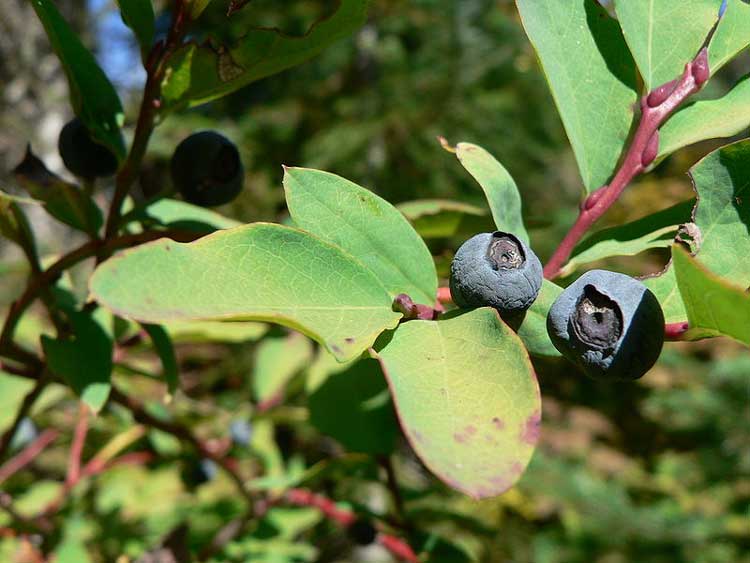
Vaccinium ovalifolium (*)
Classification System: APG IV
Superregnum: Eukaryota
Regnum: Plantae
Cladus: Angiosperms
Cladus: Eudicots
Cladus: Core eudicots
Cladus: Asterids
Ordo: Ericales
Familia: Ericaceae
Subfamilia: Vaccinioideae
Tribus: Vaccinieae
Genus: Vaccinium
Sectio: V. sect. Myrtillus
Species: Vaccinium ovalifolium
Varietates: V. o. var. alpinum – V. o. var. sachalinense
Name
Vaccinium ovalifolium Sm., 1817
Synonyms
Vaccinium axillare Nakai
Vaccinium chamissonis Bong.
Vaccinium myrtillus Cham. & Schltdl.
Vaccinium ovalifolium f. villosum (H.Boiss.) T.Shimizu
Vaccinium ovalifolium var. villosum Boiss.
Distribution
Native distribution areas:
Continental: Northern America
Aleutes, Alaska, USA (Idaho, Michigan, Montana, Oregon, South Dakota, Washington State), Canada (Alberta, British Columbia, Labrador, Newfoundland, Nova Scotia, Northern Territories, Ontario, Quebec, Yukon)
Continental: Asia-Temperate
Japan (Hokkaido, Honshu), Russian Far East (Kuril Isl., Kamchatka)
References: Brummitt, R.K. 2001. TDWG – World Geographical Scheme for Recording Plant Distributions, 2nd Edition
References
Primary references
Smith, J.E. in A. Rees, Cyclopaedia, or, an Universal Dictionary of Arts and Sciences 36: Vaccinium no. 2 (1817)
Links
Hassler, M. 2020. Vaccinium ovalifolium. World Plants: Synonymic Checklists of the Vascular Plants of the World In: Roskovh, Y., Abucay, L., Orrell, T., Nicolson, D., Bailly, N., Kirk, P., Bourgoin, T., DeWalt, R.E., Decock, W., De Wever, A., Nieukerken, E. van, Zarucchi, J. & Penev, L., eds. 2020. Species 2000 & ITIS Catalogue of Life. Published on the internet. Accessed: 2020 May 29. Reference page.
Govaerts, R. et al. 2020. Vaccinium ovalifolium in Kew Science Plants of the World online. The Board of Trustees of the Royal Botanic Gardens, Kew. Published on the internet. Accessed: 2020 May 29. Reference page.
International Plant Names Index. 2020. Vaccinium ovalifolium. Published online. Accessed: May 29 2020.
Tropicos.org 2020. Vaccinium ovalifolium. Missouri Botanical Garden. Published on the internet. Accessed: 2020 May 29.
USDA, ARS, Germplasm Resources Information Network. Vaccinium ovalifolium in the Germplasm Resources Information Network (GRIN), U.S. Department of Agriculture Agricultural Research Service. Accessed: 2017 Sep 28.
Vernacular names
English: Alaska blueberry, early blueberry, oval-leaf blueberry
Vaccinium ovalifolium (commonly known as Alaska blueberry, early blueberry, oval-leaf bilberry, oval-leaf blueberry, and oval-leaf huckleberry)[2] is a plant in the heath family having three varieties, all of which grow in northerly regions, including the subarctic.[2]
Growth
Vaccinium ovalifolium is a spreading shrub which may grow to 5 feet (1.5 m) tall. It has pink 1⁄4 in (0.64 cm) urn-shaped flowers. Berries are dark blue, often black, sometimes with a waxy coating.[6][7]
Distribution
The original variety (i.e. the automatically named Vaccinium ovalifolium var[iety] ovalifolium) is found on both the eastern and western sides of the Pacific Ocean; in North America, it is distributed in Canada (in Alberta, British Columbia, Newfoundland, Nova Scotia, southern Ontario, south central Quebec, and southern Yukon Territory); and the United States (in southern Alaska, Idaho, northern Michigan, Oregon, western South Dakota, and Washington);[8] across the Pacific to Asia and Eurasia, it is distributed in Russia (in Kamchatka, the southern Kuril Islands, Primorsky Krai, and Sakhalin); and in Japan (in Hokkaido, and central and northern Honshu).[2]
The two other varieties are confined to Japan and Russia:
V. o. var. sachalinense is only found in Sakhalin in Russia, and Hokkaido in Japan.[5]
V. o. var. alpinum is distributed only within the Daisetsu and Hidaka Mountains, both on the island of Hokkaido.[3]
Uses
Vaccinium ovalifolium is used in jams and jellies and for making liqueur. Blueberry herbal tea can be made from the leaves, or from the juice of the blueberries themselves.[6]
Vaccinium ovalifolium has been used in Russia in the making of dyes, including the use of its tannin.[2]
In the winter, Vaccinium ovalifolium is an important food source for grazing deer, goats, and elk, and in the summer the nectar feeds hummingbirds.[6]
Older bark is greyish, but twigs are brown, yellow or reddish.
References
Vaccinium ovalifolium was originally collected for classification from Alaska by botanist Archibald Menzies between 1787–1788; and later described and published by botanist James Edward Smith in The Cyclopaedia; or, Universal Dictionary of Arts, Sciences and Literature (by Abraham Rees), London. 36: Vaccinium #2. 1817. "Name - Vaccinium ovalifolium Sm". Tropicos. Saint Louis, Missouri: Missouri Botanical Garden. Retrieved November 10, 2012.
"Vaccinium ovalifolium". Germplasm Resources Information Network (GRIN). Agricultural Research Service (ARS), United States Department of Agriculture (USDA). Retrieved November 10, 2012.
Journal of Japanese Botany 62:128. 1987. "Vaccinium ovalifolium var. alpinum". Germplasm Resources Information Network (GRIN). Agricultural Research Service (ARS), United States Department of Agriculture (USDA). Retrieved November 10, 2012.
"Vaccinium ovalifolium var. ovalifolium". Germplasm Resources Information Network (GRIN). Agricultural Research Service (ARS), United States Department of Agriculture (USDA). Retrieved November 10, 2012.
Journal of Japanese Botany 62:128. 1987. "Vaccinium ovalifolium var. sachalinense". Germplasm Resources Information Network (GRIN). Agricultural Research Service (ARS), United States Department of Agriculture (USDA). Retrieved November 10, 2012.
Ewing, Susan (1996). The Great Alaska Nature Factbook. Portland, Oregon: Alaska Northwest Books. ISBN 0-88240-454-7.
Flora of North America, Vaccinium ovalifolium Smith 1817.
Biota of North America Program 2014 staate-level distribution map
Retrieved from "http://en.wikipedia.org/"
All text is available under the terms of the GNU Free Documentation License

